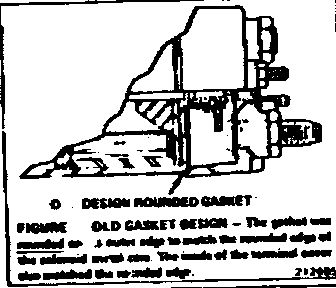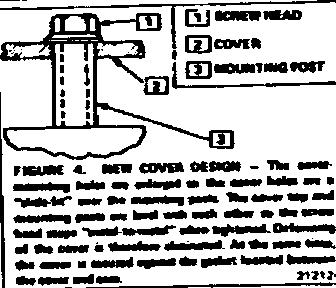SOLENOID DESIGN CHANGE ENGINE CRANKING MOTORS

SUBJECT: SOLENOID DESIGN CHANGE
Two solenoid design changes were made in production on cranking motors.
This changeover was completed mid 1981 so that all 1982 passenger cars and light duty trucks will have the new design.
Figure 1. Old Gasket Design - The gasket was rounded on its outer edge to match the rounded edge of the solenoid metal case. The inside of the terminal cover also matched the rounded edge.
Figure 2. New Gasket Design - The gasket now is completely flat, with the terminal cover redesigned to match the flat surface on the outer edge of the gasket. This new design results in better sealing between the terminal cover and case.
Figure 3. Old Cover Design - The two cover mounting holes were large enough only to accept the two attaching screws. The cover material, when assembled, was compressed between the attaching screw heads and the mounting posts. With age, the material could deform, resulting in a less-effective seal.
Figure 4. New Cover Design - The cover-mounting holes are enlarged so the cover holes are a "slide-fit" over the mounting posts. The cover top and mounting posts are level with each other so the screw head stops "metal-to-metal" when tightened. Deforming of the cover is therefore eliminated. At the same time the cover is secured againist the gasket located between the cover and case.
To facilitate assembly, there must be a very small clearance between the cover holes and mounting posts. Even after assembly, this clearance could allow the cover to be rotated slightly by hand, relative to the metal case, if sufficient effort is applied. This apparent "looseness" is normal and is not a cause for concern. Because of differences in overall dimensions and thread sizes, these two solenoid types are not interchangeable for service purposes.




General Motors bulletins are intended for use by professional technicians, not a "do-it-yourselfer". They are written to inform those technicians of conditions that may occur on some vehicles, or to provide information that could assist in the proper service of a vehicle. Properly trained technicians have the equipment, tools, safety instructions and know-how to do a job properly and safely. If a condition is described, do not assume that the bulletin applies to your vehicle, or that your vehicle will have that condition. See a General Motors dealer servicing your brand of General Motors vehicle for information on whether your vehicle may benefit from the information.
